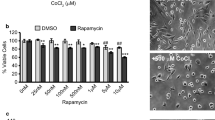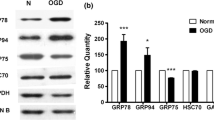Abstract
This study was undertaken to evaluate whether chemical hypoxia-induced cell injury is a result of reactive oxygen species (ROS) generation, ATP depletion, mitochondrial permeability transition, and an increase in intracellular Ca2+, in A172 cells, a human glioma cell line. Chemical hypoxia was induced by incubating cells with antimycin A, an inhibitor of mitochondrial electron transport, in a glucose-free medium. Exposure of cells to chemical hypoxia resulted in cell death, ROS generation, ATP depletion, and mitochondrial permeability transition. The H2O2 scavenger pyruvate prevented cell death, ROS generation, and mitochondrial permeability transition induced by chemical hypoxia. In contrast, changes mediated by chemical hypoxia were not affected by hydroxyl radical scavengers. Antioxidants did not affect cell death and ATP depletion induced by chemical hypoxia, although they prevented ROS production and mitochondrial permeability transition induced by chemical hypoxia. Chemical hypoxia did not increase lipid peroxidation even when antimycin A was increased to 50 μM, whereas the oxidant t-butylhydroperoxide caused a significant increase in lipid peroxidation, at a concentration that is less effective than chemical hypoxia in inducing cell death. Fructose protected against cell death and mitochondrial permeability transition induced by chemical hypoxia. However, ROS generation and ATP depletion were not prevented by fructose. Chemical hypoxia caused the early increase in intracellular Ca2+. The cell death and ROS generation induced by chemical hypoxia were altered by modulation of intracellular Ca2+ concentration with ruthenium red, TMB-8, and BAPTA/AM. However, mitochondrial permeability transition was not affected by these compounds. These results indicate that chemical hypoxia causes cell death, which may be, in part, mediated by H2O2 generation via a lipid peroxidation-independent mechanism and elevated intracellular Ca2+. In addition, these data suggest that chemical hypoxia-induced cell death is not associated directly with ATP depletion and mitochondrial permeability transition.
Similar content being viewed by others
REFERENCES
Lemasters, J. J., Nieminen, A. L., Qian, T., Trost, L. C., and Herman, B. 1997. The mitochondrial permeability transition in toxic, hypoxic and reperfusion injury. Mol. Cell. Biochem. 174:159-165.
Pocock, J. M. and Nicholls, D. G. 1998. Exocytotic and nonexocytotic modes of glutamate release from cultured cerebellar granule cells during chemical ischaemia. J. Neurochem. 70:806-813.
Gunasekar, P. G., Borowitz, J. L., and Isom, G. E. 1998. Cyanide-induced generation of oxidative species: Involvement of nitric oxide synthase and cyclooxygenase-2. J. Pharmacol. Exp. Ther. 285:236-241.
Aizenman, E., Sinor, J. D., Brimecombe, J. C., and Herin, G. A. 2000. Alterations of N-methyl-D-aspartate receptor properties after chemical ischemia. J. Pharmacol. Exp. Ther. 295:572-577.
Pastorino, J. G., Snyder, J. W., Serroni, A., Hoek, J. B., and Farber, J. L. 1993. Cyclosporin and carnitine prevent the anoxic death of cultured hepatocytes by inhibiting the mitochondrial permeability transition. J. Biol. Chem. 268:13791-13798.
Kroemer, G., Dallaporta, B., and Resche-Rigon, M. 1998. The mitochondrial death/life regulator in apoptosis and necrosis. Annu. Rev. Physiol. 60:619-642.
Tatton, W. G. and Olanow, C. W. 1999. Apoptosis in neurodegenerative diseases: The role of mitochondria. Biochim. Biophys. Acta 1410:195-213.
Lipton, P. 1999. Ischemic cell death in brain neurons. Physiol. Rev. 79:1431-1568.
Goldberg, W. P. and Choi, D. W. 1993. Combined oxygen and glucose deprivation in cortical cell cuture: Calcium-dependent and calcium-independent mechanisms of neuronal injury. J. Neurosci. 13:3510-3524.
Kristain, T. and Siesjo, B. K. 1996. Calcium in ischemic cell death. Life Sci. 59:357-367.
Donohoe, P. H., Fahlman, C. S., Bicker, P. E., Vexler, Z. S., and Gregory, G. A. 2001. Neuroprotection and intracellular Ca2+ modulation with fructose-1,6-bisphosphate during in vitro hypoxia-ischemia involves phospholipase C-dependent signaling. Brain Res. 917:158-166.
Pastorino, J. G., Snyder, J. W., Hoek, J. B., and Farber, J. L. 1995. Ca2+ depletion prevents anoxic death of hepatocytes by inhibiting mitochondrial permeability transition. Am. J. Physiol. 268:C676-C685.
Shi, L. C., Wang, H. Y., and Friedman, E. 1998. Onvolvement of platelet-activating factor in cell death induced under ischemia/postischemia-like conditions in an immortalized hippocampal cell line. J. Neurochem. 70:1035-1044.
Jurkowitz-Alexander, M. S., Altschuld, R. A., Hohl, C. M., Johnson, J. D., McDonald, J. S., Simmons, T. D., and Horrocks, L. A. 1992. Cell swelling, blebbing, and death are dependent on ATP depletion and independent of calcium during chemical hypoxia in a glial cell line (ROC-1). J. Neurochem. 59:344-352.
Pastorino, J. G., Simbula, G., Gilfor, E., Hoek, J. B., and Farber, J. L. 1994. Protoporphyrin IX, an endogenous ligand of the peripheral benzodiazepine receptor, potentiates induction of the mitochondrial permeability transition and the killing of cultured hepatocytes by rotenone. J. Biol. Chem. 269:31041-31046.
Kim, Y. K., Lee, S. K., Ha, M. S., Woo, J. S., and Jung, J. S. 2002. Differential role of reactive oxygen species in chemical hypoxia-induced cell injury in opossum kidney cells and rabbit renal cortical slices. Exp. Nephrol. 10:275-284.
Desagher, S., Glowinski, J., and Premont, J. 1996. Astrocytes protect neurons from hydrogen peroxide toxicity. J. Neurosci. 16:2553-2562.
Makar, T. K., Nedergaard, M., Preuss, A., Gelbard, A. S., Perumal, A. S., and Cooper, A. J. 1994. Vitamin E, ascorbate, glutathione, glutathione disulfide, and enzymes of glutathione metabolism in cultures of chick astrocytes and neurons: Evidence that astrocytes play an important role in antioxidative processes in the brain. J. Neurochem. 62:45-53.
Swanson, R. A. 1992. Astrocyte glutamate uptake during chemical hypoxia in vitro. Neurosci. Lett. 147:143-146.
Rose, C. R., Waxman, S. G., and Ransom, B. R. 1998. Effects of glucose deprivation, chemical hypoxia, and simulated ischemia on Na+ homeostasis in rat spinal cord astrocytes. J. Neurosci. 18:3554-3562.
Almeida, A., Almeida, J., Bolanos, J. P., and Moncada S. 2001. Different responses of astrocytes and neurons to nitric oxide: The role of glycolytically generated ATP in astrocyte protection. Proc. Natl. Acad. Sci. USA 98:15294-15299.
Denizot, F. and Lang, R. 1986. Rapid colorimetric assay for cell growth and survival: Modifications to the tetrazolium dye procedure giving improved sensitivity and reliability. J. Immunol. Methods 89:271-277.
Bass, D. A., Parce, J. W., Dechatelet, L. R., Szejda, P., Seeds, M. C., and Thomas, M. 1983. Flow cytometric studies of oxidative product formation by neutrophils: A graded response to membrane stimulation. J. Immunol. 130:1910-1917.
Lebel, C. P., Ischiropoulos, H., and Bondy, S. C. 1992. Evaluation of the probe 2′, 7′-dichlorofluorescin as an indicator of reactive oxygen species formation and oxidative stress. Chem. Res. Toxicol. 5:227-231.
Rosenkranz, A. R., Schmaldienst, S., Stuhlmeier, K. M., Chen, W., Knapp, W., and Zlabinger, G. J. 1992. A microplate assay for the detection of oxidative products using 2′, 7′-dichlorofluorescin-diacetate. J. Immunol. Methods 156:39-45.
Uchiyama, M. and Mihara, M. 1978. Determination of malonaldehyde precursor in tissues by thiobarbituric acid test. Anal. Biochem. 86:271-278.
Bradford, M. M. 1976. A rapid and sensitive method for the quantitation of microgram quantities of protein utilizing the principle of protein-dye binding. Anal. Biochem. 72:248-254.
Lizard, G., Fournel, S., Genestier, L., Dhedin, N., Chaput, C., Flacher, M., Mutin, M., Panaye, G., and Revillard, J. P. 1995. Kinetics of plasma membrane and mitochondrial alterations in cells undergoing apoptosis. Cytometry 21:275-283.
Pastorino, J. G., Chen, S. T., Tafani, M., Snyder, J. W., and Farber, J. L. 1998. The overexpression of Bax produces cell death upon induction of the mitochondrial permeability transition. J. Biol. Chem. 273:7770-7775.
Hesketh, T. R., Smith, G. A., Moore, J. P., Taylor, M. V., and Metcalfe, J. C. 1983. Free cytoplasmic calcium concentration and the mitogenic stimulation of lymphocytes. J. Biol. Chem. 258:4876-4882.
Nieminen, A. L., Saylor, A. K., Tesfai, S. A., Herman, B., and Lemasters, J. J. 1995. Contribution of the mitochondrial permeability transition to lethal injury after exposure of hepatocytes to t-butylhydroperoxide. Biochem. J. 307:99-106.
Krippner, A., Matsuno-Yagi, A., Gottlieb, R. A., and Babior, B. M. 1996. Loss of function of cytochrome c in Jurkat cells undergoing fas-mediated apoptosis. J. Biol. Chem. 271:21629-21636.
Frenkel, K. and Gleichauf, C. 1991. Hydrogen peroxide formation by cells treated with a tumor promoter. Free Radic. Res. Commun. 12-13:783-794.
Koppenol, W. H. 1993. Generation and thermodynamic properties of oxyradicals. Pages 1-10, inC. Vigo-Pelfery (eds.), Membrane lipid oxidation. CRC Press, Boca Raton.
Halliwell, B., Gutteridge, J. M. C., and Cross, C. E. 1992. Free radicals, antioxidants, and human disease: Where are we now? J. Lab. Clin. Med. 119:598-620.
Kappus, H. and Reinhold, C. 1994. Heavy metal-induced cytotoxicity to cultured human epidermal keratinocytes and effects of antioxidants. Toxicol. Lett. 71:105-109.
Anundi, I., King, J., Owen, D. A., Schneider, H., Lemasters, J. J., and Thurman, R. G. 1987. Fructose prevents hypoxic cell death in liver. Am. J. Physiol. 253:G390-G396.
Nieminen, A. L., Dawson, T. L., Gores, G. J., Kawanishi, T., Herman, B., and Lemasters, J. J. 1990. Protection by acidotic pH and fructose against lethal injury to rat hepatocytes from mitochondrial inhibitors, ionophores and oxidant chemicals. Biochem. Biophys. Res. Commun. 167:600-606.
Zhang, J. G., Tirmenstein, M. A., Nicholls-Grzemski, F. A., and Fariss, M. W. 2001. Mitochondrial electron transport inhibitors cause lipid peroxidation-dependent and-independent cell death: Protective role of antioxidants. Arch. Biochem. Biophys. 393:87-96.
Ueda, N., Mayeux, P. R., Walker, P. D., and Shah, S. V. 1991. Receptor-mediated increase in cytosolic calcium in LLC-PK1 cells by platelet activating factor and thromboxane A2. KidneyInt. 40:1075-1081.
Carter, W. O., Narayanan, P. K., and Robinson J. P. 1994. Intracellular hydrogen peroxide and superoxide anion detection in endothelial cells. J. Leukoc. Biol. 55:253-258.
Gunasekar, P. G., Sun, P. W., Kanthasamy, A. G., Borowitz, J. L., and Isom, G. E. 1996. Cyanide-induced neurotoxicity involves nitric oxide and reactive oxygen species generation after N-methyl-D-aspartate receptor activation. J. Pharmacol. Exp. Ther. 277:150-155.
Farber, J. L., Kyle, M. E., and Coleman, J. B. 1990. Biology of disease: Mechanisms of cell injury by activated oxygen species. Lab. Invest. 62:670-679.
Lee, Y. W., Ha, M. S., and Kim, Y. K. 2001. H2O2-induced cell death in human glioma cells: Role of lipid peroxidation and PARP activation. Neurochem. Res. 26:337-343.
Muller, U. and Krieglstein, J. 1995. Inhibitors of lipid peroxidation protect cultured neurons against cyanide-induced injury. Brain Res. 678:265-268.
Myers, K. M., Fiskum, G., Liu, Y., Simmens, S. J., Bredesen, D. E., and Murphy, A. N. 1995. Bcl-2 protects neural cells from cyanide/aglycemia-induced lipid oxidation, mitochondrial injury, and loss of viability. J. Neurochem. 65:2432-2440.
Pauwels, P. J., Opperdoes, F. R., and Trouet, A. 1985. Effects of antimycin, glucose deprivation, and serum on cultures of neurons, astrocytes, and neuroblastoma cells. J. Neurochem. 44:143-148.
Thies, R. L. and Autor, A. P. 1991. Reactive oxygen injury to cultured pulmonary artery endothelial cells: Mediation by poly(ADP-ribose)polymerase activation causing NAD depletion and altered energy balance. Arch. Biochem. Biophys. 286:353-363.
Andreoli, S. P. and Mallett, C. P. 1997. Disassociation of oxidant-induced ATP depletion and DNA damage from early cytotoxicity in LLC-PK1 cells. Am. J. Physiol. 272:F729-F735.
Wang, J., Green, P. S., and Simpkins, J. W. 2001. Estradiol protects against ATP depletion, mitochondrial membrane potential decline and the generation of reactive oxygen species induced by 3-nitroproprionic acid in SK-N-SH human neuroblastoma cells. J. Neurochem. 77:804-811.
Nicotera, P., Thor, H., and Orrenius, S. 1989. Cytosolic-free Ca2+ and cell killing in hepatoma 1c1c7 cells exposed to chemical anoxia. FASEB J. 3:59-64.
Lemasters, J. J., DiGuiseppi, J., Nieminen, A. L., and Herman, B. 1987. Blebbing, free Ca2+ and mitochondrial membrane potential preceeding cell death in hepatocytes. Nature 325:79-81.
Author information
Authors and Affiliations
Corresponding author
Rights and permissions
About this article
Cite this article
Jeong, J.I., Lee, Y.W. & Kim, Y.K. Chemical Hypoxia-Induced Cell Death in Human Glioma Cells: Role of Reactive Oxygen Species, ATP Depletion, Mitochondrial Damage and Ca2+ . Neurochem Res 28, 1201–1211 (2003). https://doi.org/10.1023/A:1024280429036
Issue Date:
DOI: https://doi.org/10.1023/A:1024280429036




